Effects of Charged Martian Dust on Martian Atmosphere Remote Sensing
Abstract
:1. Introduction
2. Model Description
2.1. Charged Martian Dust Particles
2.2. Surface Conductivity Model
2.3. Core-Shell Model
3. Results and Discussions
3.1. Extinction Properties of Charged Martian Dust
3.2. Effect of the Net Charge on the Martian Dust Optical Depth
4. Conclusions
Author Contributions
Funding
Institutional Review Board Statement
Informed Consent Statement
Data Availability Statement
Acknowledgments
Conflicts of Interest
References
- Fonseca, R.M.; Zorzano, M.P.; Martín-Torres, J. MARSWRF prediction of entry descent landing profiles: Applications to Mars exploration. Earth Space Sci. 2019, 6, 1440–1459. [Google Scholar] [CrossRef]
- Fenton, L.; Reiss, D.; Lemmon, M.; Marticorena, B.; Cantor, B. Orbital Observations of Dust Lofted by Daytime Convective Turbulence. Space Sci. Rev. 2016, 203, 89–142. [Google Scholar] [CrossRef] [Green Version]
- McCleese, D.; Schofield, J.; Taylor, F.; Calcutt, S.; Foote, M.; Kass, D.; Leovy, C.; Paige, D.; Read, P.; Zurek, R. Mars Climate Sounder: An investigation of thermal and water vapor structure, dust and condensate distributions in the atmosphere, and energy balance of the polar regions. J. Geophys. Res. Planets 2007, 112, E05S06. [Google Scholar] [CrossRef] [Green Version]
- Altunaiji, E.; Edwards, C.; Smith, M.; Christensen, P.; AlMheiri, S.; Reed, H. Emirates Mars Infrared Spectrometer (EMIRS) Overview from the Emirates Mars Mission. In Proceedings of the EGU General Assembly Conference Abstracts, Vienna, Austria, 23–28 April 2017; p. 15037. [Google Scholar]
- Wolff, M.J.; Clancy, R.T. Constraints on the size of Martian aerosols from Thermal Emission Spectrometer observations. J. Geophys. Res. Planets 2003, 108, 5097. [Google Scholar] [CrossRef]
- Fedorova, A.A.; Montmessin, F.; Rodin, A.V.; Korablev, O.I.; Bertaux, J.L. Evidence for a bimodal size distribution for the suspended aerosol particles on Mars. Icarus 2014, 231, 239–260. [Google Scholar] [CrossRef]
- Montabone, L.; Lewis, S.R.; Read, P.L.; Withers, P. Reconstructing the weather on Mars at the time of the MERs and Beagle 2 landings. Geophys. Res. Lett. 2006, 33, 692. [Google Scholar] [CrossRef] [Green Version]
- Haberle, R.M.; Clancy, R.T.; Forget, F.; Smith, M.D.; Zurek, R.W. The Atmosphere and Climate of Mars; Cambridge University Press: Cambridge, UK, 2017. [Google Scholar]
- Cantor, B.A.; Pickett, N.B.; Malin, M.C.; Lee, S.W.; Wolff, M.J.; Caplinger, M.A. Martian Dust Storm Activity near the Mars 2020 Candidate Landing Sites: MRO-MARCI Observations from Mars Years 28–34. Icarus 2018, 321, 161–170. [Google Scholar] [CrossRef]
- Tang, Z.; Liu, J.; Wang, X.; Ren, X.; Yan, W.; Chen, W. The Temporal Variation of Optical Depth in the Candidate Landing Area of China’s Mars Mission (Tianwen-1). Remote Sens. 2021, 13, 1029. [Google Scholar] [CrossRef]
- Dabrowska, D.D.; Muñoz, O.; Moreno, F.; Ramos, J.L.; Martínez-Frías, J.; Wurm, G. Scattering matrices of martian dust analogs at 488nm and 647nm. Icarus 2015, 250, 83–94. [Google Scholar] [CrossRef]
- Marra, A.C.; Blanco, A.; Fonti, S.; Jurewicz, A.; Orofino, V. Fine hematite particles of Martian interest: Absorption spectra and optical constants. J. Phys. Conf. 2005, 6, 132–138. [Google Scholar] [CrossRef]
- Glotch, T.D.; Rossman, G.R.; Aharonson, O. Mid-infrared (5–100 μm) reflectance spectra and optical constants of ten phyllosilicate minerals. Icarus 2007, 192, 605–622. [Google Scholar] [CrossRef]
- Montabone, L.; Forget, F.; Millour, E.; Wilson, R.; Lewis, S.; Cantor, B.; Kass, D.; Kleinböhl, A.; Lemmon, M.; Smith, M. Eight-year climatology of dust optical depth on Mars. Icarus 2015, 251, 65–95. [Google Scholar] [CrossRef] [Green Version]
- Draine, B.T. Interstellar dust grains. Annu. Rev. Astron. Astrophys. 2003, 41, 241–289. [Google Scholar] [CrossRef] [Green Version]
- Rudge, W.D. Atmospheric electrification during South African dust storms. Nature 1913, 91, 31–32. [Google Scholar] [CrossRef] [Green Version]
- Kok, J.F.; Renno, N.O. Electrostatics in wind-blown sand. Phys. Rev. Lett. 2008, 100, 014501. [Google Scholar] [CrossRef] [Green Version]
- Mazumder, M.K.; Calle, C.I.; Pruessner, K.; Sharma, R.; Srirama, P.K.; Ali, M.; Immer, C.; Trigwell, S.; Clements, J.S.; Biris, A.S.; et al. Research needs in electrostatics for Lunar and Mars space missions. In Proceedings of the Fourtieth IAS Annual Meeting. Conference Record of the 2005 Industry Applications Conference, Hong Kong, China, 2–6 October 2005; Volume 321, pp. 327–333. [Google Scholar]
- Eden, H.F.; Vonnegut, B. Electrical Breakdown Caused by Dust Motion in Low-Pressure Atmospheres: Considerations for Mars. Science 1973, 180, 962–963. [Google Scholar] [CrossRef]
- Mazumder, M.K.; Srirama, P.; Sharma, R.; Biris, A.; Hidetaka, I.; Trigwell, S.; Horenstein, M. Lunar and Martian dust dynamics. IEEE Ind. Appl. Mag. 2010, 16, 14–21. [Google Scholar] [CrossRef]
- Melnik, O.; Parrot, M. Electrostatic discharge in Martian dust storms. J. Geophys. Res. Atmos. 1998, 103, 29107–29118. [Google Scholar] [CrossRef]
- Moore, A.D. Electrostatics and Its Applications; John Wiley & Sons: Hoboken, NJ, USA, 1973. [Google Scholar]
- Farrell, W.; Kaiser, M.; Desch, M.; Houser, J.; Cummer, S.; Wilt, D.; Landis, G. Detecting electrical activity from Martian dust storms. J. Geophys. Res. Planets 1999, 104, 3795–3801. [Google Scholar] [CrossRef]
- Merrison, J.; Jensen, J.; Kinch, K.; Mugford, R.; Nørnberg, P. The electrical properties of Mars analogue dust. Planet. Space Sci. 2004, 52, 279–290. [Google Scholar] [CrossRef]
- Bohren, C.F.; Hunt, A.J. Scattering of electromagnetic waves by a charged sphere. Can. J. Phys. 1977, 55, 1930–1936. [Google Scholar] [CrossRef]
- Klačka, J.; Kocifaj, M. Scattering of electromagnetic waves by charged spheres and some physical consequences. J. Quant. Spectrosc. Radiat. Transf. 2007, 106, 170–183. [Google Scholar] [CrossRef]
- Heinisch, R.L.; Bronold, F.X.; Fehske, H. Mie scattering by a charged dielectric particle. Phys. Rev. Lett. 2012, 109, 243903. [Google Scholar] [CrossRef] [PubMed] [Green Version]
- Bohren, C.F.; Huffman, D.R. Absorption and Scattering of Light by Small Particles; John Wiley & Sons Inc: Hoboken, NJ, USA, 1983. [Google Scholar]
- Aden, A.L.; Kerker, M. Scattering of electromagnetic waves from two concentric spheres. J. Appl. Phys. 1951, 22, 1242–1246. [Google Scholar] [CrossRef]
- Franzese, G.; Esposito, F.; Lorenz, R.; Silvestro, S.; Popa, C.I.; Molinaro, R.; Cozzolino, F.; Molfese, C.; Marty, L.; Deniskina, N. Electric properties of dust devils. Earth Planet. Sci. Lett. 2018, 493, 71–81. [Google Scholar] [CrossRef]
- Tomme, E.B.; Law, D.A.; Annaratone, B.M.; Allen, J.E. Parabolic plasma sheath potentials and their implications for the charge on levitated dust particles. Phys. Rev. Lett. 2000, 85, 2518–2521. [Google Scholar] [CrossRef] [Green Version]
- Koren, I.; Ganor, E.; Joseph, J.H. On the relation between size and shape of desert dust aerosol. J. Geophys. Res. Atmos. 2001, 106, 18047–18054. [Google Scholar] [CrossRef]
- Yang, P.; Feng, Q.; Hong, G.; Kattawar, G.W.; Wiscombe, W.J.; Mishchenko, M.I.; Dubovik, O.; Laszlo, I.; Sokolik, I.N. Modeling of the scattering and radiative properties of nonspherical dust-like aerosols. J. Aerosol Sci. 2007, 38, 995–1014. [Google Scholar] [CrossRef]
- Brown, A.M.; Sheldon, M.T.; Atwater, H.A. Electrochemical tuning of the dielectric function of Au nanoparticles. ACS Photonics 2015, 2, 459–464. [Google Scholar] [CrossRef] [Green Version]
- Klacka, J.; Kocifaj, M. On the Scattering of Electromagnetic Waves by a Charged Sphere. Prog. Electromagn. Res. 2010, 109, 17–35. [Google Scholar] [CrossRef] [Green Version]
- Fan, X.; Zheng, W.; Singh, D.J. Light scattering and surface plasmons on small spherical particles. Light Sci. Appl. 2014, 3, e179. [Google Scholar] [CrossRef] [Green Version]
- Klačka, J.; Kocifaj, M.; Kundracik, F.; Videen, G.; Kohút, I. Generalization of electromagnetic scattering by charged grains through incorporation of interband and intraband effects. Opt. Lett. 2015, 40, 5070–5073. [Google Scholar] [CrossRef] [PubMed]
- Gierasch, P.J.; Goody, R.M. A Model of a Martian Great Dust Storm. J. Atmos. Sci. 1973, 30, 169–179. [Google Scholar] [CrossRef] [Green Version]
- Gierasch, P.J. Martian dust storms. Rev. Geophys. 1974, 12, 730. [Google Scholar] [CrossRef]
- Montmessin, F.; Quémerais, E.; Bertaux, J.-L.; Korablev, O.; Rannou, P.; Lebonnois, S. Stellar occultations at UV wavelengths by the SPICAM instrument: Retrieval and analysis of Martian haze profiles. J. Geophys. Res. Planets 2006, 111, E09S09. [Google Scholar] [CrossRef] [Green Version]
- Rannou, P.; Perrier, S.; Bertaux, J.L.; Montmessin, F.; Korablev, O.; Reberac, A. Dust and cloud detection at the Mars limb with UV scattered sunlight with SPICAM. J. Geophys. Res. Planets 2006, 111, E09S10. [Google Scholar] [CrossRef]
- Fedorova, A.; Korablev, O.; Bertaux, J.; Rodin, A.; Montmessin, F.; Belyaev, D.; Reberac, A. Solar infrared occultations by the SPICAM experiment on Mars-Express: Simultaneous observations of H2O, CO2 and aerosol vertical distribution. In Proceedings of the AAS/Division for Planetary Sciences Meeting Abstracts #39, id.31.03, Orlando, FL, USA, 7–12 October 2007. [Google Scholar]
- Clancy, R.T.; Wolff, M.J.; Whitney, B.A.; Cantor, B.A.; Smith, M.D.; McConnochie, T.H. Extension of atmospheric dust loading to high altitudes during the 2001 Mars dust storm: MGS TES limb observations. Icarus 2010, 207, 98–109. [Google Scholar] [CrossRef]
- Calle, C.I. Electrostatic Phenomena on Planetary Surfaces; Morgan & Claypool Publishers: San Rafael, CA, USA, 2017. [Google Scholar]
- Toon, O.B.; Pollack, J.B.; Sagan, C. Physical properties of the particles composing the Martian dust storm of 1971–1972. Icarus 1977, 30, 663–696. [Google Scholar] [CrossRef]
- Juluri, B.K.; Zheng, Y.B.; Ahmed, D.; Jensen, L.; Huang, T.J. Effects of Geometry and Composition on Charge-Induced Plasmonic Shifts in Gold Nanoparticles. J. Phys. Chem. C 2008, 112, 7309–7317. [Google Scholar] [CrossRef]
- Rosenkrantz, E.; Arnon, S. Enhanced absorption of light by charged nanoparticles. Opt. Lett. 2010, 35, 1178–1180. [Google Scholar] [CrossRef]
- Byers, C.P.; Zhang, H.; Swearer, D.F.; Yorulmaz, M.; Hoener, B.S.; Huang, D.; Hoggard, A.; Chang, W.-S.; Mulvaney, P.; Ringe, E. From tunable core-shell nanoparticles to plasmonic drawbridges: Active control of nanoparticle optical properties. Sci. Adv. 2015, 1, e1500988. [Google Scholar] [CrossRef] [PubMed] [Green Version]
- Zapata Herrera, M.; Aizpurua, J.; Kazansky, A.K.; Borisov, A.G. Plasmon response and electron dynamics in charged metallic nanoparticles. Langmuir 2016, 32, 2829–2840. [Google Scholar] [CrossRef] [PubMed]
- Zhou, Z.; Zhang, S.; Qi, J.; Yang, X. Extension of complex refractive index model and analysis of scattering properties of charged submicron spheres. J. Quant. Spectrosc. Radiat. Transf. 2020, 242, 106735. [Google Scholar] [CrossRef]
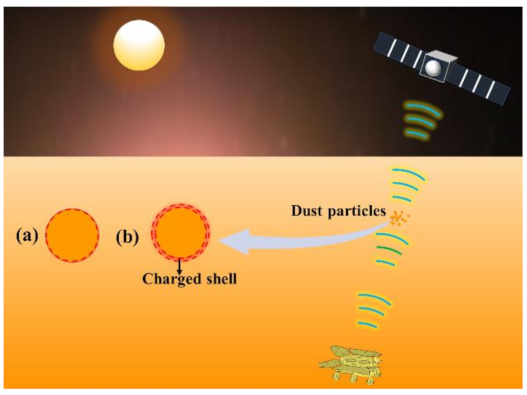
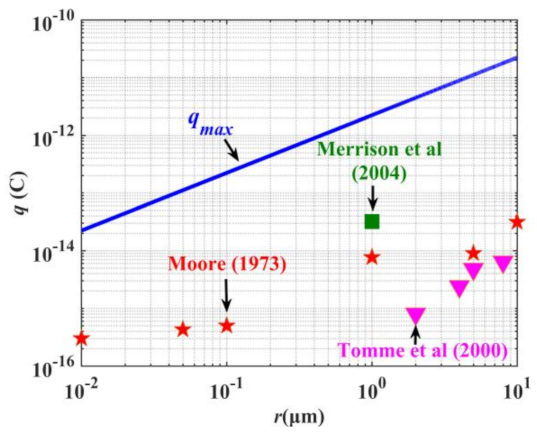

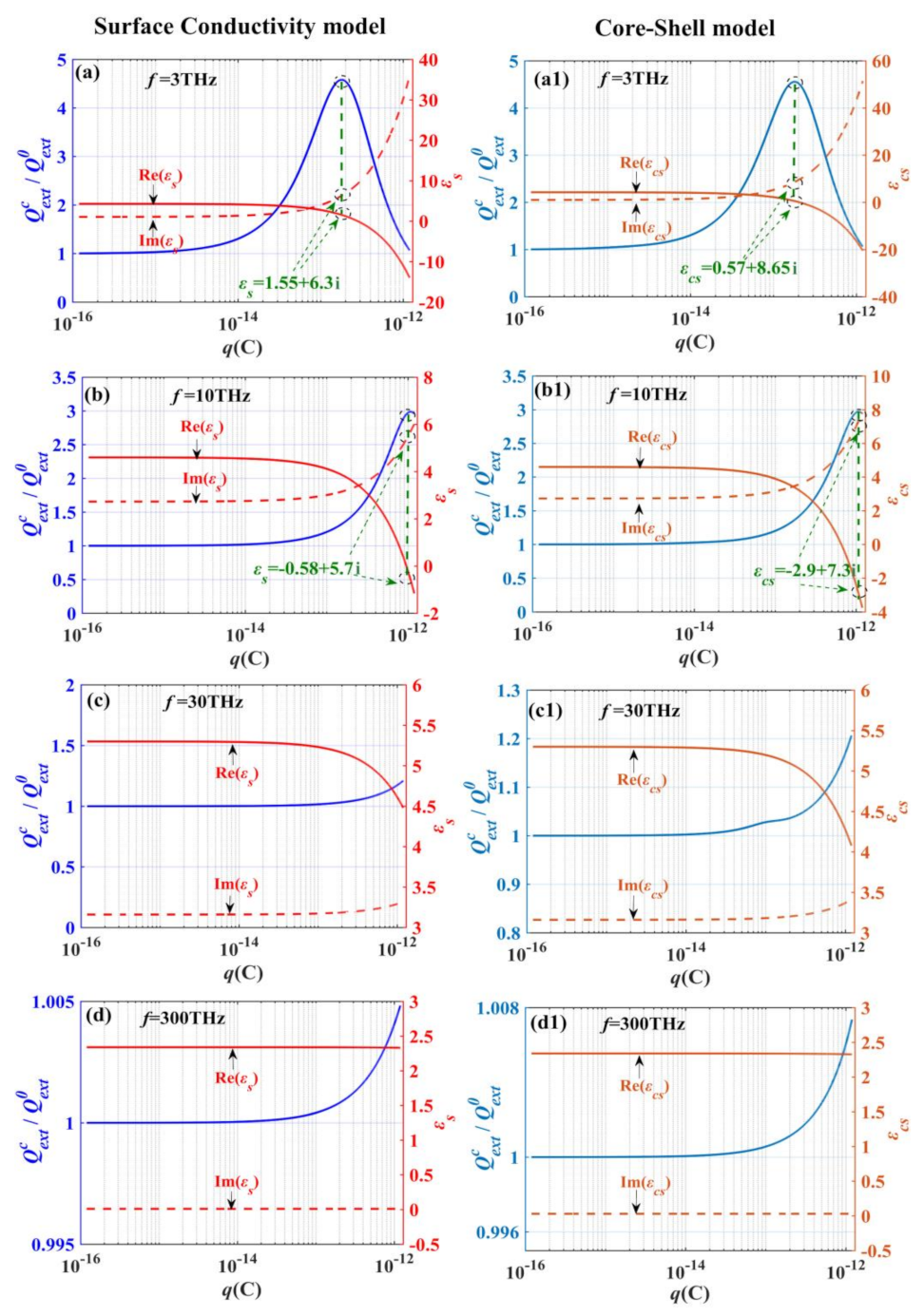
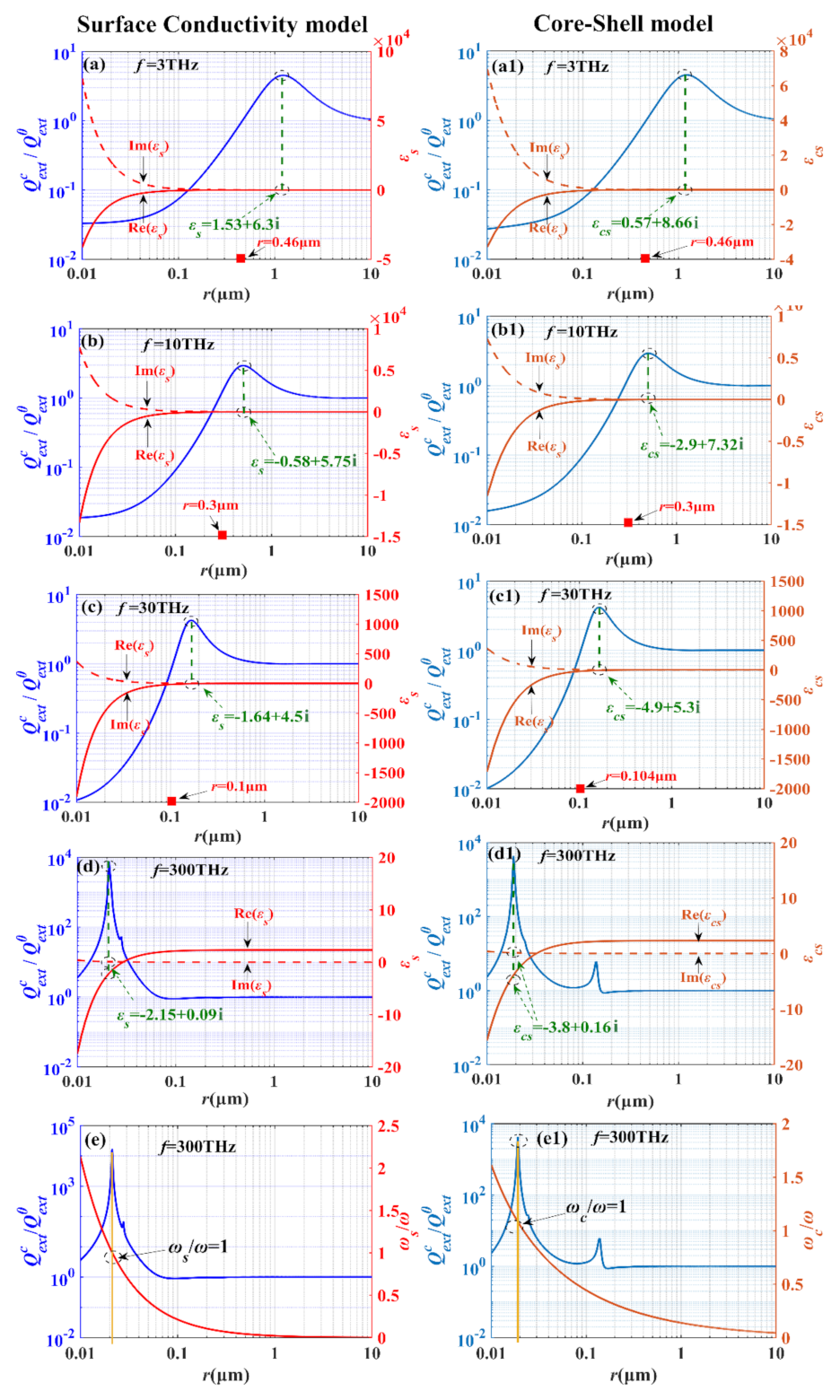

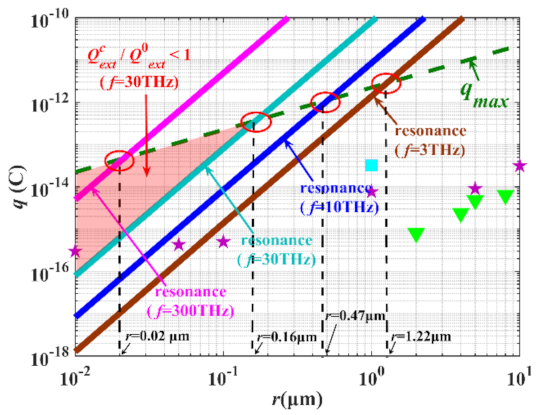
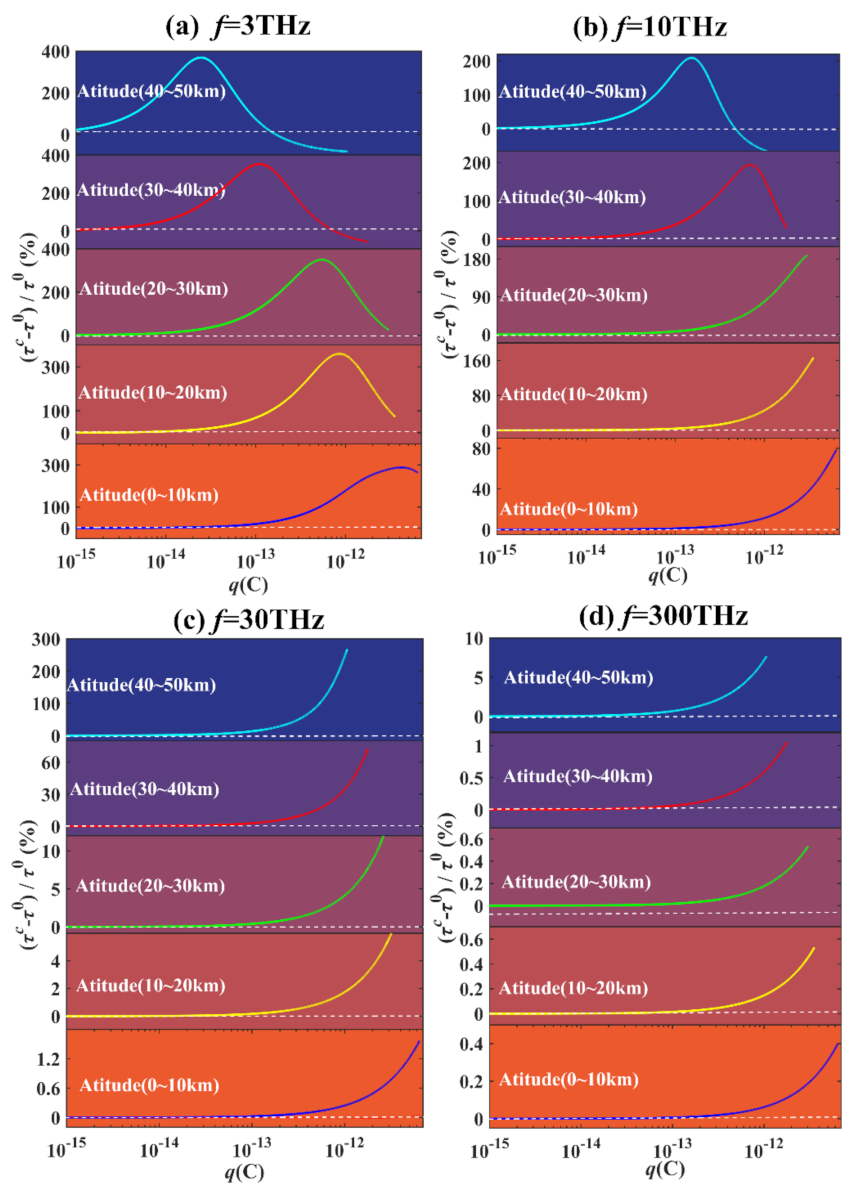
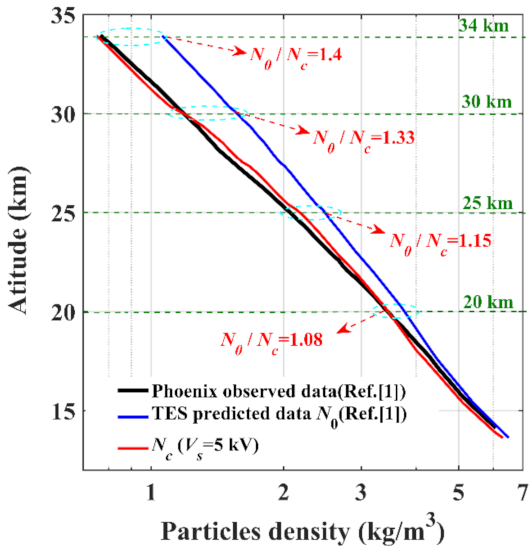
| Frequency | Surface Conductivity Model | Core-Shell Model | ||
|---|---|---|---|---|
| Radius | εs | Radius | εcs | |
| f = 3 THz | 1.2 μm | 1.55 + 6.3i | 1.2 μm | 0.57 + 8.66i |
| f = 10 THz | 0.5 μm | −0.58 + 5.75i | 0.5 μm | −2.9 + 7.32i |
| f = 30 THz | 0.17 μm | −1.64 + 4.5i | 0.165 μm | −4.9 + 5.3i |
| f = 300 THz | 0.02 μm | −2.15 + 0.09i | 0.019 μm | −3.8 + 0.16i |
Publisher’s Note: MDPI stays neutral with regard to jurisdictional claims in published maps and institutional affiliations. |
© 2022 by the authors. Licensee MDPI, Basel, Switzerland. This article is an open access article distributed under the terms and conditions of the Creative Commons Attribution (CC BY) license (https://creativecommons.org/licenses/by/4.0/).
Share and Cite
Gao, X.; Xie, L.; Dou, X.; Zhou, J. Effects of Charged Martian Dust on Martian Atmosphere Remote Sensing. Remote Sens. 2022, 14, 2072. https://doi.org/10.3390/rs14092072
Gao X, Xie L, Dou X, Zhou J. Effects of Charged Martian Dust on Martian Atmosphere Remote Sensing. Remote Sensing. 2022; 14(9):2072. https://doi.org/10.3390/rs14092072
Chicago/Turabian StyleGao, Xuebang, Li Xie, Xuqiang Dou, and Jun Zhou. 2022. "Effects of Charged Martian Dust on Martian Atmosphere Remote Sensing" Remote Sensing 14, no. 9: 2072. https://doi.org/10.3390/rs14092072
APA StyleGao, X., Xie, L., Dou, X., & Zhou, J. (2022). Effects of Charged Martian Dust on Martian Atmosphere Remote Sensing. Remote Sensing, 14(9), 2072. https://doi.org/10.3390/rs14092072






